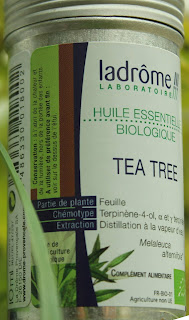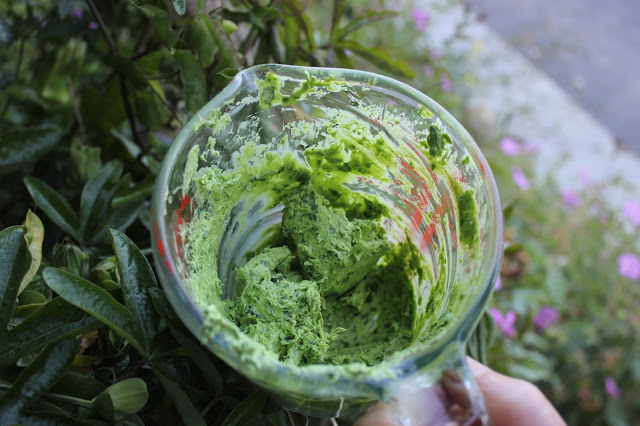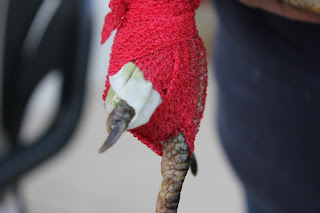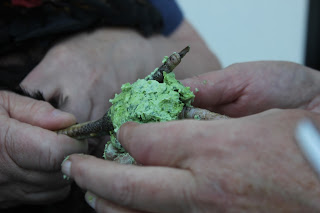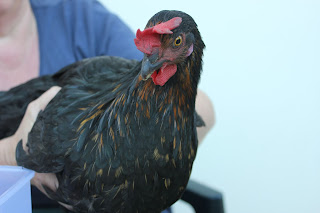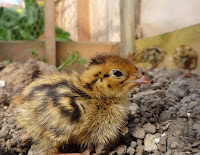In the first part of this article, which you can find here we discussed the behaviour of the mite, why and how your quail might suffer an infestation and the link between the latter and nutritional deficiency.
In the following we will look at how to treat scaly leg and scaly face with organic, readily-available, effective and low cost solutions. The initial idea would be to suffocate the mite by using a viscous substance such as an organic vegetable oil which will be harmless to the bird but will block up the breathing tubes (spiracles) or rudimentary lungs. However, when I first had to deal with external parasites many years ago, I read a lab report in which it was documented that arthropods treated solely with a carrier oil had in fact been able to 'hold their breath' for more than an hour. Thus their breathing apparatus had had time to absorb the oil, become unblocked and therefore the mites had been able to survive the treatment. Thus I have a combination of remedies to use in different areas where the mite is present.
In the following we will look at how to treat scaly leg and scaly face with organic, readily-available, effective and low cost solutions. The initial idea would be to suffocate the mite by using a viscous substance such as an organic vegetable oil which will be harmless to the bird but will block up the breathing tubes (spiracles) or rudimentary lungs. However, when I first had to deal with external parasites many years ago, I read a lab report in which it was documented that arthropods treated solely with a carrier oil had in fact been able to 'hold their breath' for more than an hour. Thus their breathing apparatus had had time to absorb the oil, become unblocked and therefore the mites had been able to survive the treatment. Thus I have a combination of remedies to use in different areas where the mite is present.
Communicate
Your bird will be very grateful to you for solving this problem as parasite infestations are, as you can imagine, a horrible thing to endure. However, your quail may not enjoy being treated for them. Talk to your birds throughout the treatment, reassuring them by the tone of your voice that all is well. If you have noticed the similarities between human and bird-speak, then you will already understand that tone and cadence are all important. Your quail will instinctively know what you are saying.Raw Organic Virgin Coconut Oil
 One of the most important grocery items ever present in my kitchen cupboard and which is also a powerful medicinal is raw, organic coconut oil. Although more expensive than other organic oils which can be used as carriers for essential oil, coconut oil has virtues of its own. It is therefore invaluable in areas such as the eyes, ears, nose mouth and vent, where treatment with essential oil (of this further) is inadvisable. Coconut oil
contains
lauric, capric and caprylic acids, these have wide ranging properties,
such as insecticidal, antimicrobial, antioxidant, anti-fungal,
antibacterial and soothing qualities. Coconut oil is a great support for
the immune system and has both healing properties for the skin and
promotes the regrowth of feathers/hair. We use it in cooking as well as
in making cosmetics. Although a saturated fat coconut oil is made up of
two thirds medium-chain fats aka medium-chain triglycerides or MCTs,
these are metabolised in a completely different way to most fats, in
that they do not need bile or digestive enzymes. Thus, when used
internally, MCTs in coconut oil are readily available for use by both
the body and the brain and not stored as in the usual way of fats. In
the case of a stressed, tired bird or one lacking in energy due to mite
activity, this is an assured way of giving a great boost to both motor
and nervous system function. So when I treat externally with coconut
oil, I always make sure the bird gets a nice nugget of coconut oil to
eat as well - my birds love it! In the case of quail, who are sometimes fussy about new tastes, I add coconut oil and turmeric to boiled rice and when we eat it they get the scrapings from the bottom of the pan!
One of the most important grocery items ever present in my kitchen cupboard and which is also a powerful medicinal is raw, organic coconut oil. Although more expensive than other organic oils which can be used as carriers for essential oil, coconut oil has virtues of its own. It is therefore invaluable in areas such as the eyes, ears, nose mouth and vent, where treatment with essential oil (of this further) is inadvisable. Coconut oil
contains
lauric, capric and caprylic acids, these have wide ranging properties,
such as insecticidal, antimicrobial, antioxidant, anti-fungal,
antibacterial and soothing qualities. Coconut oil is a great support for
the immune system and has both healing properties for the skin and
promotes the regrowth of feathers/hair. We use it in cooking as well as
in making cosmetics. Although a saturated fat coconut oil is made up of
two thirds medium-chain fats aka medium-chain triglycerides or MCTs,
these are metabolised in a completely different way to most fats, in
that they do not need bile or digestive enzymes. Thus, when used
internally, MCTs in coconut oil are readily available for use by both
the body and the brain and not stored as in the usual way of fats. In
the case of a stressed, tired bird or one lacking in energy due to mite
activity, this is an assured way of giving a great boost to both motor
and nervous system function. So when I treat externally with coconut
oil, I always make sure the bird gets a nice nugget of coconut oil to
eat as well - my birds love it! In the case of quail, who are sometimes fussy about new tastes, I add coconut oil and turmeric to boiled rice and when we eat it they get the scrapings from the bottom of the pan!
Lauric
acid makes up about half of the fatty acids in coconut oil. When lauric
acid is digested, it transforms into a monoglyceride called monolaurin.
Both lauric acid and monolaurin aid in ridding the gut of an overgrowth of harmful
pathogens such as bacteria, viruses, fungi and parasites. This, as we
have already discussed in previous articles on parasites, is a
bonus in the case of external mites, where continued activity can have
compromised the gut and thus the immune system and digestive processes.
So even if your bird is now eating well it may still not be able to
extract the nutrients from its food. Coconut oil therefore is a most
important asset to your medicine chest.
 These are suitable inexpensive carrier oils for use when treating the legs, I usually try to recuperate organic oil from the large, ex bulk-storage olive jars given away when empty by my local organic shop. I always ask them not to bother to pre-wash them as I have a use for the remaining oil.
These are suitable inexpensive carrier oils for use when treating the legs, I usually try to recuperate organic oil from the large, ex bulk-storage olive jars given away when empty by my local organic shop. I always ask them not to bother to pre-wash them as I have a use for the remaining oil.
As discussed above killing the mites by suffocation, i.e preventing them from accessing oxygen is not sufficient and treating several birds with the more potent coconut oil can get quite expensive. Thus the addition of an essential oil with insecticidal properties is necessary to be sure of removing them from the host.
Tea tree also has wound healing properties and as these mites can cause skin lesions, this is a very welcome extra virtue. As so little oil is used in each treatment and as a typical 10 ml bottle of pure essential oil translates to 250 drops, it is worth investing in the best quality organic.
Organic Olive, Sunflower Oil or Similar
 These are suitable inexpensive carrier oils for use when treating the legs, I usually try to recuperate organic oil from the large, ex bulk-storage olive jars given away when empty by my local organic shop. I always ask them not to bother to pre-wash them as I have a use for the remaining oil.
These are suitable inexpensive carrier oils for use when treating the legs, I usually try to recuperate organic oil from the large, ex bulk-storage olive jars given away when empty by my local organic shop. I always ask them not to bother to pre-wash them as I have a use for the remaining oil.As discussed above killing the mites by suffocation, i.e preventing them from accessing oxygen is not sufficient and treating several birds with the more potent coconut oil can get quite expensive. Thus the addition of an essential oil with insecticidal properties is necessary to be sure of removing them from the host.
Essential Oil - Tea Tree (Melaleuca alternifolia)
For both scaly face and scaly leg I use Tea tree essential oil as amongst its many properties it is an insecticide and is used in organic farming as such. In fact it was a farmer friend of mine, who shadowed an organic vet as part of her continuing education, who first recommended tea tree to me as a cure for scaly leg many years ago.Tea tree also has wound healing properties and as these mites can cause skin lesions, this is a very welcome extra virtue. As so little oil is used in each treatment and as a typical 10 ml bottle of pure essential oil translates to 250 drops, it is worth investing in the best quality organic.
Why I Use Organic Cotton Hygiene and Health Products
Cotton is one of the most chemically intensive crops in the world and cotton defoliants are the most toxic farm chemicals currently on the market. Cotton farming accounts for 25% of the World's insecticide use and at a cost of, on average per year, $2.6 billion. As an anecdotal incidence, my friend's mother in Alabama never wore cotton her whole life and warned constantly against the dangers. Think though how much worse it is to use conventionally-grown cotton products on damaged skin and open wounds.Scaly Face - Treating the Sensitive Areas of the Face
Be generous in your use of coconut oil, as with all microscopic creatures, it is easy for some of them to avoid direct contact with the treatment. In a serious scaly face infestation, as you apply the coconut oil, layers of these creatures and their debris will be removed, so to avoid any being reapplied and surviving, change the cotton bud often as practical. It is also possible as you get nearer to the skin that you will remove creatures that have burrowed below the surface, this may cause redness and maybe even some slight bleeding. Stop the 'cleaning' treatment of these areas immediately if this happens and instead just gently pat on some coconut oil. This will both aid in skin repair and stop, by the antimicrobial effect of the coconut oil, any potential infection.Scaly Face on the Neck or on Facial Areas Excluding the Above
It will be most unlikely that your quail would just get scaly face around the ears, mouth and other sensitive areas mentioned above so it is on the non-sensitive places that you can carry out the full (essential oil) scaly-face treatment.

At the back of the neck, around the top of the head or to treat any other area away from the ear, eye, nose or beak, I add one drop of tea tree essential oil to a teaspoonful of melted (carrier) coconut oil. This is the recommended dilution of essential oil for each bird needing treatment.
Thus, if I have a very large area to treat and run out of the essential oil/carrier oil mixture, I revert back to just using the pure coconut oil. There are several reasons why I only like to use 1 drop of tea tree when treating scaly face. The first being because tea tree is a strong oil and I don't like to use too much on the skin (unless as with my pigeon, in an earlier article, this is a case of gangrene or infection). Secondly because one of the greatest receptors for essential oil is through the lungs and as I'm treating the bird in areas in close proximity to its nose I know it will be accessing oil by inhalation too, therefore I keep the dose to a maximum of one drop per day. That does not mean I do not treat a bird's legs on the same day because it would be very unlikely that I would ever need to use a whole teaspoon of mix on one small quail. I would also want to treat scaly leg and scaly face together when it occurred on the same bird as I wouldn't want them passing the mite back and forth through scratching.

At the back of the neck, around the top of the head or to treat any other area away from the ear, eye, nose or beak, I add one drop of tea tree essential oil to a teaspoonful of melted (carrier) coconut oil. This is the recommended dilution of essential oil for each bird needing treatment.
Thus, if I have a very large area to treat and run out of the essential oil/carrier oil mixture, I revert back to just using the pure coconut oil. There are several reasons why I only like to use 1 drop of tea tree when treating scaly face. The first being because tea tree is a strong oil and I don't like to use too much on the skin (unless as with my pigeon, in an earlier article, this is a case of gangrene or infection). Secondly because one of the greatest receptors for essential oil is through the lungs and as I'm treating the bird in areas in close proximity to its nose I know it will be accessing oil by inhalation too, therefore I keep the dose to a maximum of one drop per day. That does not mean I do not treat a bird's legs on the same day because it would be very unlikely that I would ever need to use a whole teaspoon of mix on one small quail. I would also want to treat scaly leg and scaly face together when it occurred on the same bird as I wouldn't want them passing the mite back and forth through scratching.
Essential oils are quick acting and should only be used for a
short period, with hens I work on a schedule of five days of treatment and then five days with
no treatment before starting again, I have rarely ever got past the
first five days. The ailment has either cleared up or I have realised I
had made the wrong diagnosis and switched treatments. With my quail, I just did one treatment and then left it for a week, that was except for my quail with the scaly leg infestation, that one, as you will see below, I treated differently.
 In
extreme cases (as with my bird with the infestation), where there are many
raised scales and deep layers of excrescences, then a more radical
treatment is needed. I have found that softening the scales overnight in
the same mixture I use to relieve inflammation (see left), i.e., a cabbage and
lard poultice works wonders.
In
extreme cases (as with my bird with the infestation), where there are many
raised scales and deep layers of excrescences, then a more radical
treatment is needed. I have found that softening the scales overnight in
the same mixture I use to relieve inflammation (see left), i.e., a cabbage and
lard poultice works wonders.
If the scales are very badly deformed I will soak organic cotton wool or an organic makeup pad in the oil mix and bandage this onto the leg and keep it on overnight. This of course still respecting the 1 drop of tea tree per quail and dissolved in one to two teaspoons of carrier oil dependent on the area to be covered.
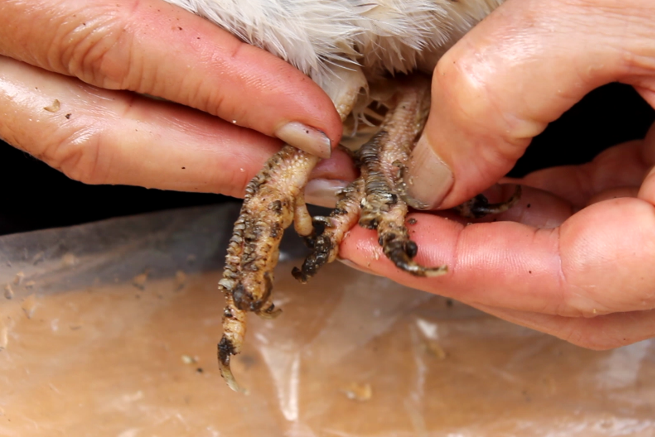
With my 'infested' quail I used an organic cotton make-up pad to rub the oil in between the badly lifted scales, after the initial soaking in the jar. As I felt the scales were loosening, I then made a tentative attack on the tops of the lifted scales. The top layer should and did, come away revealing a harder dryer layer underneath. As a tip: - if you hold the base of these excrescences tightly between finger and thumb, then you can gently remove the top part with your finger nail. The feet and legs can then be quickly dipped again to allow the oil to sink further into the scales.
In the next article I will discuss follow-up treatment and there will be a film of the whole process.
Thanks for dropping by and do feel free to share experiences or ask for further information in the comment section. If you have enjoyed this piece and found it useful think about sharing it with your family and friends, on social media and also maybe about joining this blog and/or subscribing to my Youtube channel or even supporting us on Patreon or It all helps to keep me going!
Until next time, all the very best from sunny Normandie! Sue
© 2020 Sue Cross
Scaly Leg Treatment
Its microscopic size and its nature of boring into the skin make Knemidocoptes mutans slightly more difficult to treat than other mites. You should also really treat all your birds because it takes a long time to build up colonies of mites that are big enough to cause visible damage. Therefore, chances are some other birds in your flock already have the parasite. Using an edible organic carrier oil and a small amount of essential oil will mean the bird will have no problem with cleaning up its legs once the scales have softened. I add tea tree essential oil, organic if possible and no more than 1 drop per bird (if treating individuals), dissolved into one to two teaspoon of the chosen carrier oil.
On a quail I
use an organic cotton bud or small paint brush to apply this and spread it all over
the legs including the back of the hocks up to where the feathers start.
If I am treating several birds at once then I use a small wide mouth jar filled up to
hock height with carrier oil and add up to 6 drops of tea tree. I then
mix this well and stand each bird in the pot. If the neck is wide enough then both
legs can be done but be aware that quail are incredibly strong in the legs and they will use the full force of this to get away from you, so treating one leg at a time may be a better option! I know with my own birds some take this treatment as a
breeze but others kick up a fuss so putting their feet in a jar is not
always the best option!


The quail should begin to preen around the legs and feet the minute they are
put back on the ground and as the legs and feet soften up during the day
I often see them working with their beaks around the scales. The object
as always with this branch of medicine, is to get the bird to heal
itself.
 In
extreme cases (as with my bird with the infestation), where there are many
raised scales and deep layers of excrescences, then a more radical
treatment is needed. I have found that softening the scales overnight in
the same mixture I use to relieve inflammation (see left), i.e., a cabbage and
lard poultice works wonders.
In
extreme cases (as with my bird with the infestation), where there are many
raised scales and deep layers of excrescences, then a more radical
treatment is needed. I have found that softening the scales overnight in
the same mixture I use to relieve inflammation (see left), i.e., a cabbage and
lard poultice works wonders.If the scales are very badly deformed I will soak organic cotton wool or an organic makeup pad in the oil mix and bandage this onto the leg and keep it on overnight. This of course still respecting the 1 drop of tea tree per quail and dissolved in one to two teaspoons of carrier oil dependent on the area to be covered.

With my 'infested' quail I used an organic cotton make-up pad to rub the oil in between the badly lifted scales, after the initial soaking in the jar. As I felt the scales were loosening, I then made a tentative attack on the tops of the lifted scales. The top layer should and did, come away revealing a harder dryer layer underneath. As a tip: - if you hold the base of these excrescences tightly between finger and thumb, then you can gently remove the top part with your finger nail. The feet and legs can then be quickly dipped again to allow the oil to sink further into the scales.
In the next article I will discuss follow-up treatment and there will be a film of the whole process.
Thanks for dropping by and do feel free to share experiences or ask for further information in the comment section. If you have enjoyed this piece and found it useful think about sharing it with your family and friends, on social media and also maybe about joining this blog and/or subscribing to my Youtube channel or even supporting us on Patreon or It all helps to keep me going!
Until next time, all the very best from sunny Normandie! Sue
RELATED ARTICLES
 Scaly Leg & Scaly Face in Quail Part 3 - Follow-Up Treatment
Scaly Leg & Scaly Face in Quail Part 3 - Follow-Up Treatment
Above you can see the difference after over a week of dust-bathing and
my quail working on her feet. There is still more to do but I have given ...read more
Scaly Leg/Tassel Foot & Scaly Face in Quail
Knemidocoptes mutans a very successful, microscopic burrowing mite, is one I have dealt with before within these pages in its relationship to my hens and cockerels. I also mentioned that it could....read moreTreating an injured quail Nutritional support for sprains, strains and nerve damage
Here's Drusilla she is one of my coturnix quail and over the past few
days she has started to limp, holding up her foot and hopping...read more
Treating inflammation and infection with cabbage poultices
Recently
I had occasion to use this poultice on two cases simultaneously, my quail and
my neighbour's hen's suspected bumblefoot.. ...read more
Treating a nasty head wound and shock
Our poor quail, Nuggets with a horrible injury to her head and eyes (Happy ending!) ...read more
© 2020 Sue Cross



